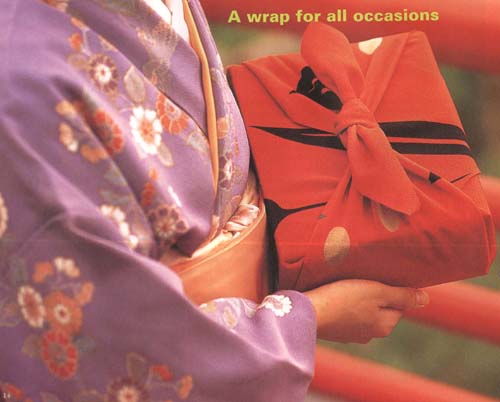|
In today's world, advances in science and technology are
occurring at such a dizzying pace that often before you have
time to understand a product, it is being replaced by a new and
better model. Japan has been at the head of many and of these
developments. However, there is one Japanese item that has remained
essentially unchanged for centuries - the furoshiki.
The furoshiki is an oversized square cloth, dyed in a variety
of colors and patterns that is used for wrapping, storing, and
carrying things. The origin of the furoshiki goes back to the
14th century, when powerful feudal lords used the cloth to wrap
their clothes in while they baths in the late 17th century.
The furoshiki, however, were employed in various ways as people
realized the versatility of these cloths. Very large furoshiki,
up to 235 square cm., can hold futon (Japanese bedding set).
the typical furoshiki is 70 square cm. and until very recently,
Japanese would not leave home without one. The fukusa is the smallest type, created
to wrap very small, delicate items.
For centuries, the furoshiki was truly an indispensable part
of daily Japanese life. In Edo times, people would lay their
futon on top of the furoshiki before going to sleep. fires were
extremely common back then, so when people had to get away in
a hurry during the night, they only had to throw their belongings
on top of the futon, wrap and tie the furoshiki, and leave through
the nearest exit. Merchants usually carried their wares inside
the furoshiki to transport just about anything you could imagine.
When the furoshiki was not in use, people would fold it up like
a handkerchief and put it away.
Why, then, are furoshiki no longer as evident as they once were?
The answer
lies in the increasing westernization and industrialization of
Japan. Once handbags and paper shopping bags arrived on the scene
in the 1950s, people found less reason to bring a furoshiki along
wherever they went. When plastic bags made their appearance in
the 1970s, the furoshiki seemed doomed.
However, the furoshiki has managed to hold its own. About one
third to a half of all furoshiki sales are wedding related. Newlywed
couples will give gifts wrapped in furoshiki to those attending
their wedding reception. The knot holding the furoshiki together
symbolized the strong union between the two families. Unfortunately,
this tradition has also been affected: as more people choose
Western-style wedding, they believe the Japanese furoshiki doesn't
fit the right image, and therefore prefer presenting the gifts
inside a paper bag.
Furoshiki wrapping techniques have been passed down through
the generations, with very little written on the subject. A decrease
in furoshiki use means fewer people know how to properly wrap
and tie furoshiki. It really does require a knack to prevent
the furoshiki from being too looser or too bulky. the furoshiki,
in many ways, is similar to the kimono. These two articles are
shapeless, designed to wrap around and fit the object inside.
For contrast, think of Western clothing, which offers a range
of sizes to fit a variety of body shapes. the kimono, on the
other hand, traditionally came in few sizes. Therefore, people
had to be adept at putting on and adjusting the kimono to fit
their own size.
Interestingly, some professions still make use of the furoshiki.
lawyers who need to bring dozens of documents and materials to
court, find that a furoshiki is much more convenient to use than
trying stuff everything into one briefcase. Public officials
also use furoshiki to transport documents are taken out of the
furoshiki, it is folded and put away. in this way, the official
shows that he has nothing to conceal.
Some Japanese citizens are trying to revive interest in the
furoshiki to prevent it from disappearing completely from Japanese
life. If the furoshiki dies out, so will the traditional colors
and patterns used on them. They point out that by using furoshiki
rather than paper or plastic bags, people can help alleviate
the growing environmental problem of waste disposal. Furthermore,
they are encouraging people to come up with original ideas for
furoshiki, such as for use in interior decoration .
In any case, the furoshiki can become an integral part of your
lifestyle. One you've mastered the wrapping technique, you will
be delighted with the convenience this cloth offers. It holds
anything and everything!
|
